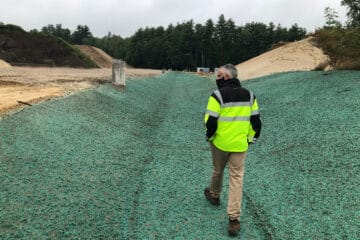
Author: Chris Nadeau, PE – Director of Commercial Services
How many times have you heard “All the good land has been developed and now we’re just left with the difficult stuff!” or “If it was easy, it would have already been developed!”? Oftentimes that’s the case, but consider this: as our appetite for different types of development and expanding municipal growth boundaries change, so does the possibility of finding land that is appropriate and relevant for the type of development you’re pursuing.
The first step in deciding whether a piece of land is worth your time and money to develop is to establish your goals. What are you trying to accomplish? What will your ideal site layout look like (size of buildings, open space, parking, etc.)? Do you need high visibility, or can you work with something off the beaten path? Not only should you set your goals, but you need to be able to communicate your goals clearly with others. Know exactly what you want, but be flexible enough to allow for modifications.
The next step is to find some properties that will meet some or most of your goals. Once you find something, you need to go through a series of due diligence steps (“kicking the tires”) to determine whether a property is worth pursuing further before you start investing large sums of money. Following are some common steps to take while in the due-diligence phase.
- Review available Geographic Information System (GIS) mapping. Many municipalities have on-line GIS mapping – find out who owns the property, look at topography, find out abutting uses, zoning, critical habitat, and natural resources.
- Review Municipal Land Use Regulations including zoning ordinance, site plan regulations, master plan, and subdivision ordinances. Is your desired use allowed? What are the dimensional constraints for a particular zone? Are there architectural and landscaping standards? Most, if not all, of this information can be found on the municipality’s website.
- Before you jump in the car, review current and historical aerial photos on Google Earth. Pay particular attention to ground cover, past development, whether there are municipal utilities (sewer, water, gas, storm drainage, electrical and telecommunications infrastructure), and what abutting land is being used for. Hint: if the ground cover is brown year-round, it might be a wetland!
- Review the State environmental databases to determine whether the property has any past or current environmental concerns.
- Perform a query with the State Division of Historical Resources to find out whether there are records of archaeological or culturally significant sensitive areas in proximity to your project.
- Perform a query with the State department responsible for overseeing critical animal and plant habitat to see if there are records of threatened or endangered species or critical habitat in the vicinity of your project.
- Contact the Department of Transportation (if the site is on a State Highway) or the local Highway Department (if it is on a local roadway, or within an urban compact zone). Will they grant an access permit? Will you be required to make roadway improvements for the use you are proposing? Are there any long-range plans to reconstruct or rehabilitate the roadway? Is the roadway under a pavement moratorium?
- Talk to a local. It could be a local real estate agent, a surveyor, an engineer, or just a friend who lives in the town. This way, you can get a sense for local flavor – whether the Town is in favor of development or whether they will fight you. Be specific about the use (retail, office, residential, etc.). Less than 5 years ago, residential development was often met with strong resistance, while commercial development was welcomed with open arms. Today, the resistance is very different. The most attractive development for municipalities is “mixed use” where you have commercial and residential usage within the same development. Today, denser is often better, but again, it depends on the municipality. It pays to ask around and get a feeling for your community’s preferences.
- Jump in your car and drive around. Perform a windshield inspection of the property to look at site access; natural features including topography, soils, and vegetation; obvious environmental issues; proximity to municipal services; and overall “curbside appeal” of the property.
At this point, you haven’t spent a dime (except for some gas money). If everything passes “the straight face test”, it might be time to hire an expert to verify or clarify your findings. If you do nothing else, spend a few hundred dollars to have a wetland scientist or land use expert perform a site reconnaissance and look for “show-stopper” issues like wetlands. You won’t regret this because nothing can be more detrimental to the development of your property than the presence of wetlands. Trust me, after 30 years in this business, I still get surprised.
For a very reasonable few thousand dollars, you can hire a land consultant or engineer to do much of this work on your behalf. Often, this low fee carrot is a promise to the expert of an actual project with more substantial fees and the establishment of a long-term relationship with you as their client. The end product can be as simple as an email summary, or a more in-depth “fatal flaw” report with a conceptual site plan that you can take to the local Town officials or Land Use Board to get their feedback on what you are proposing.
Contrary to the naysayers, there is still good land out there ready to be developed. It’s just waiting for you to make that call. By following this checklist, you’ll find the right site for the right development.